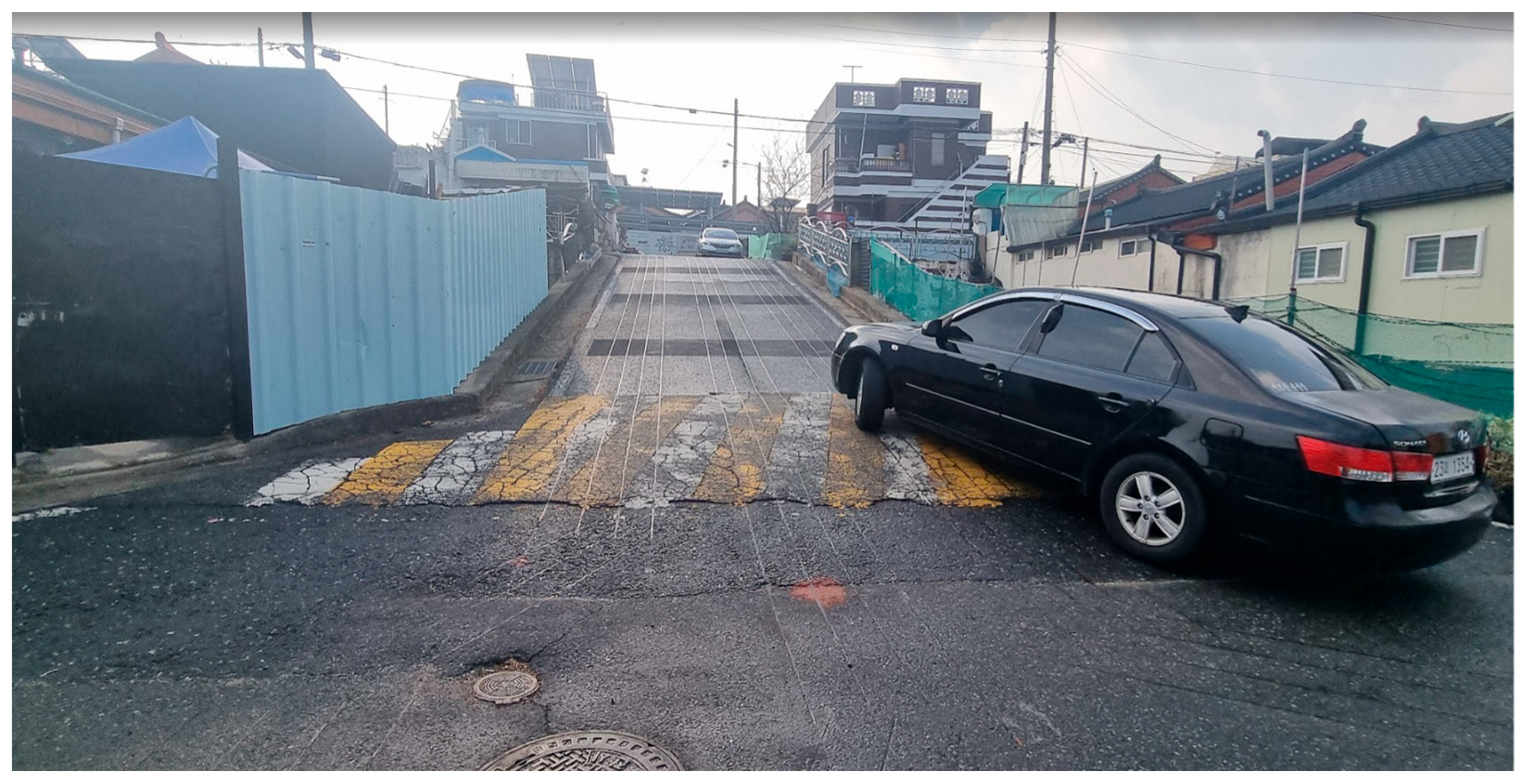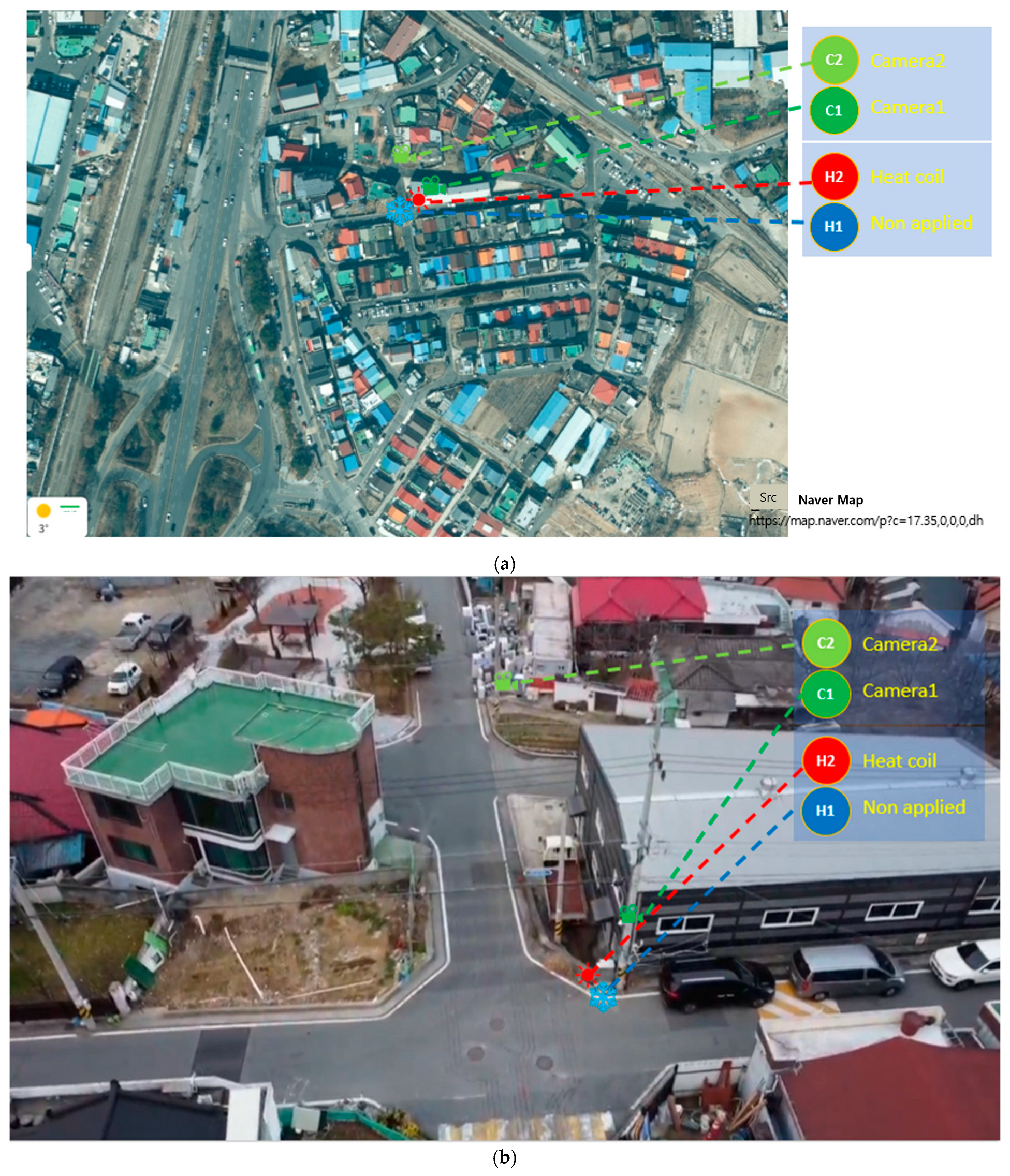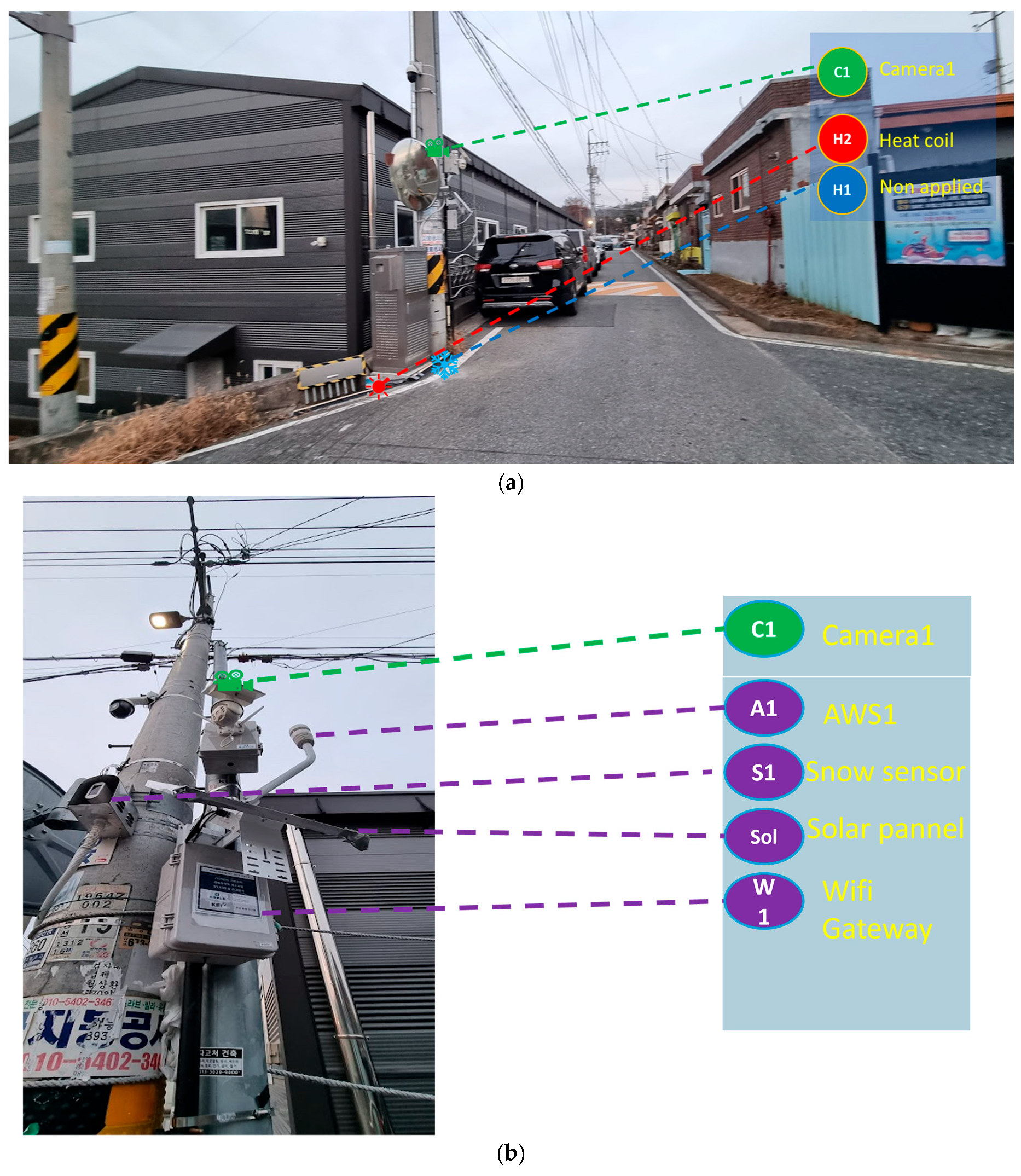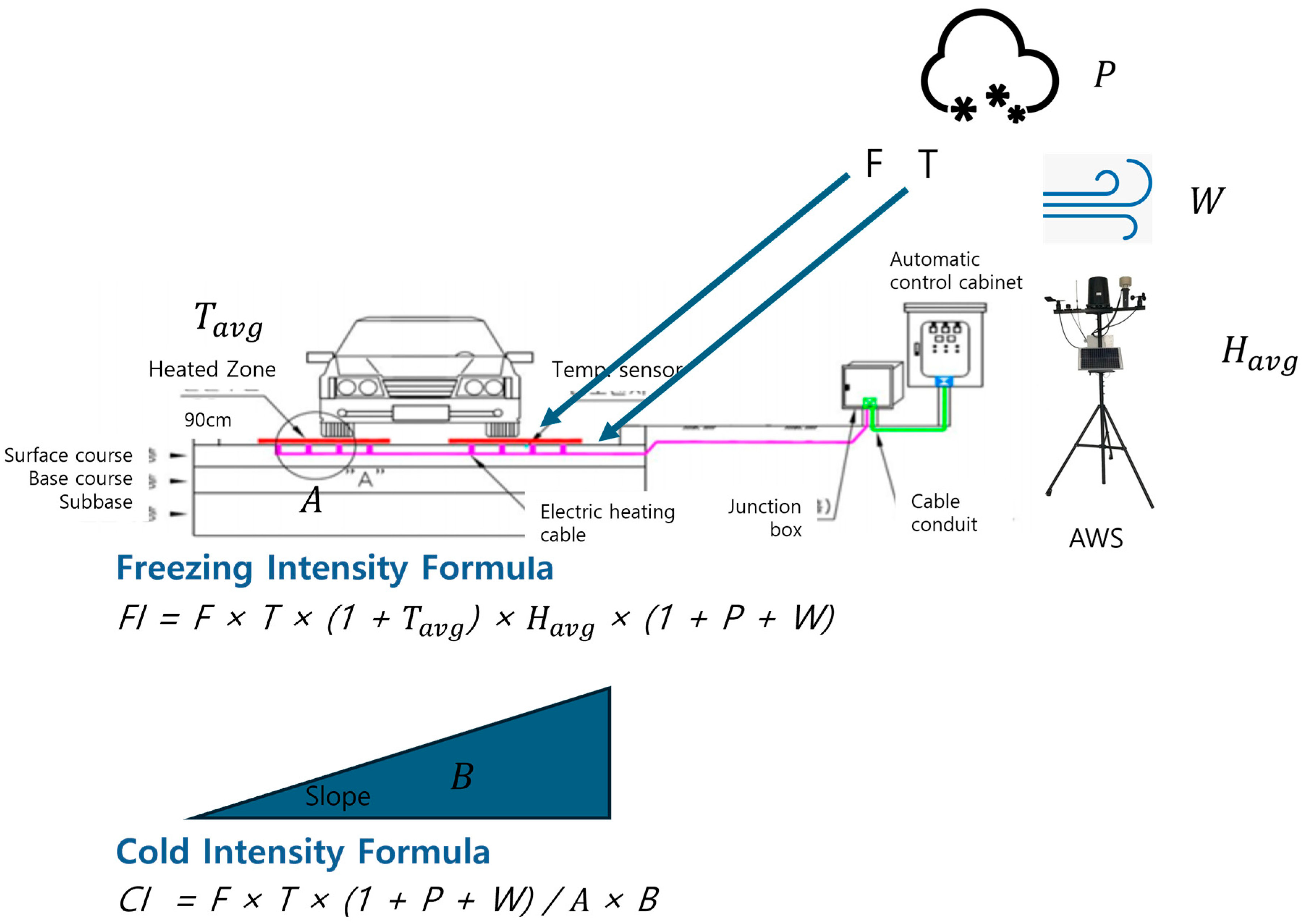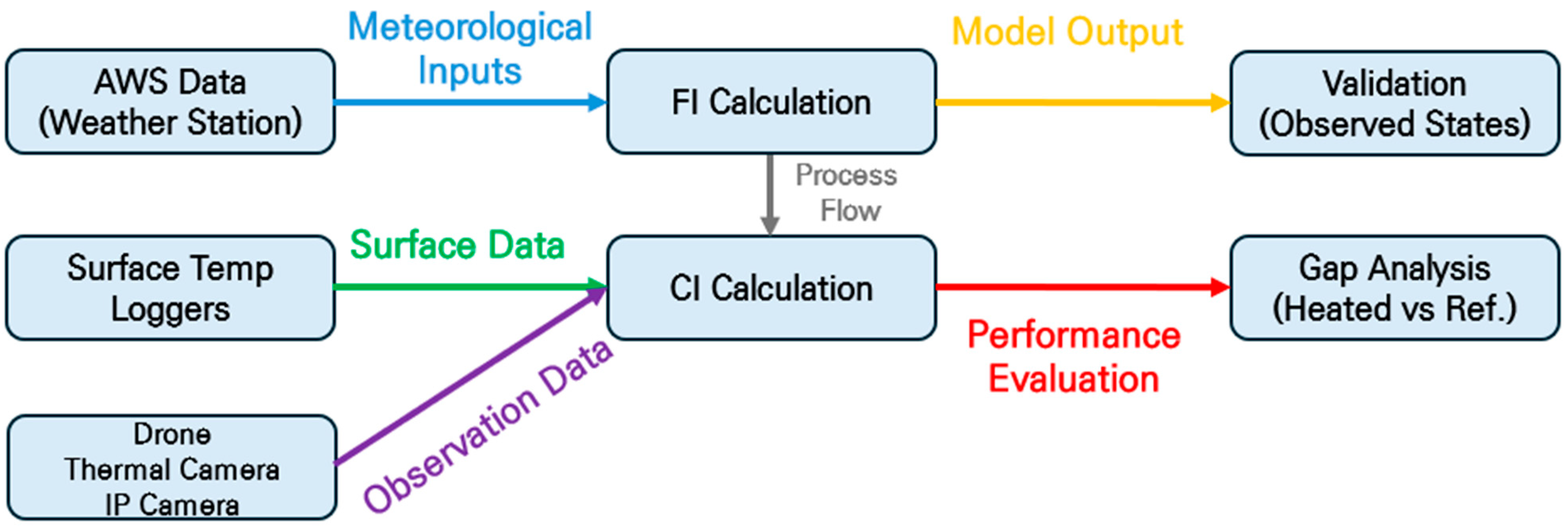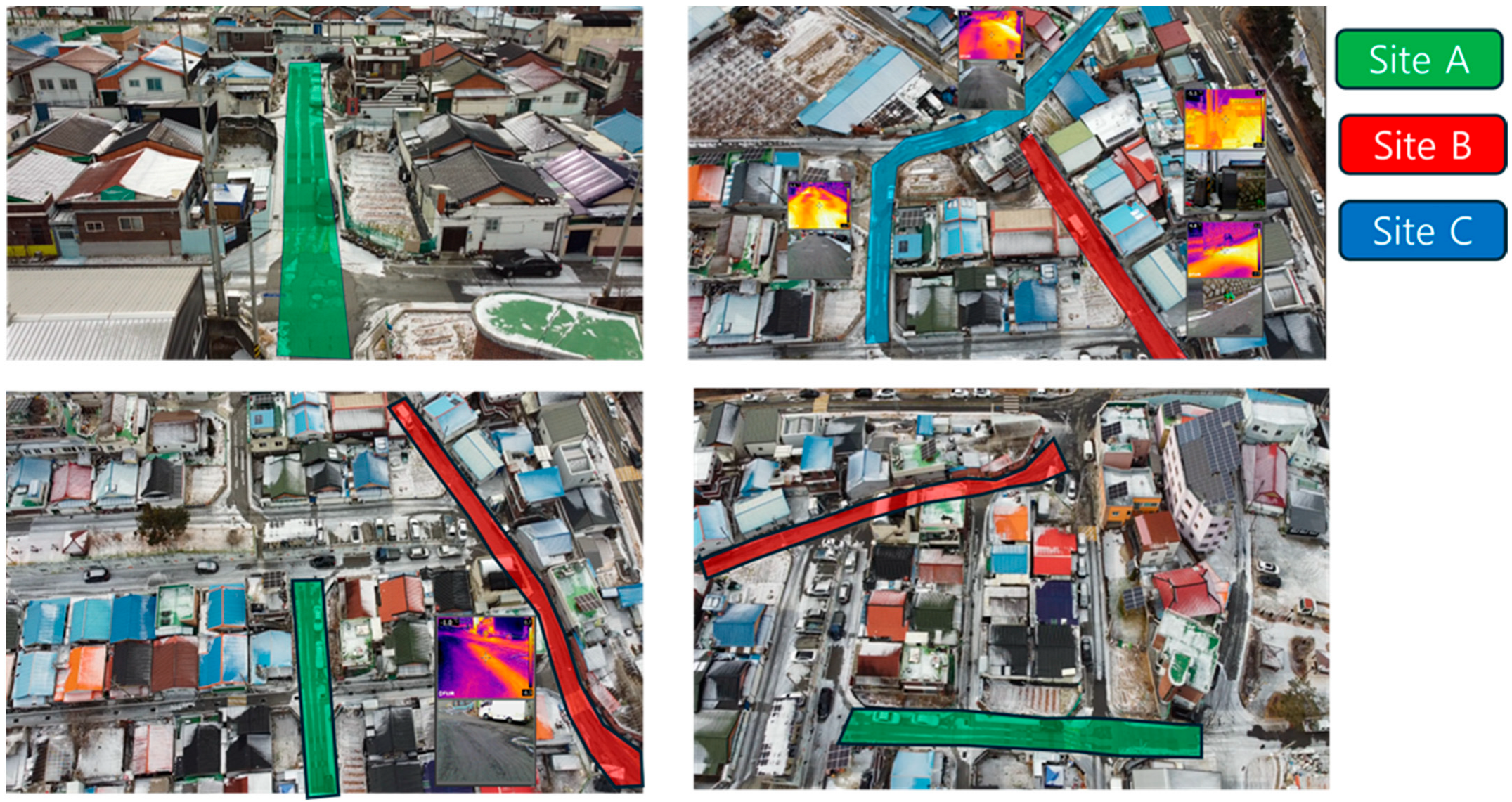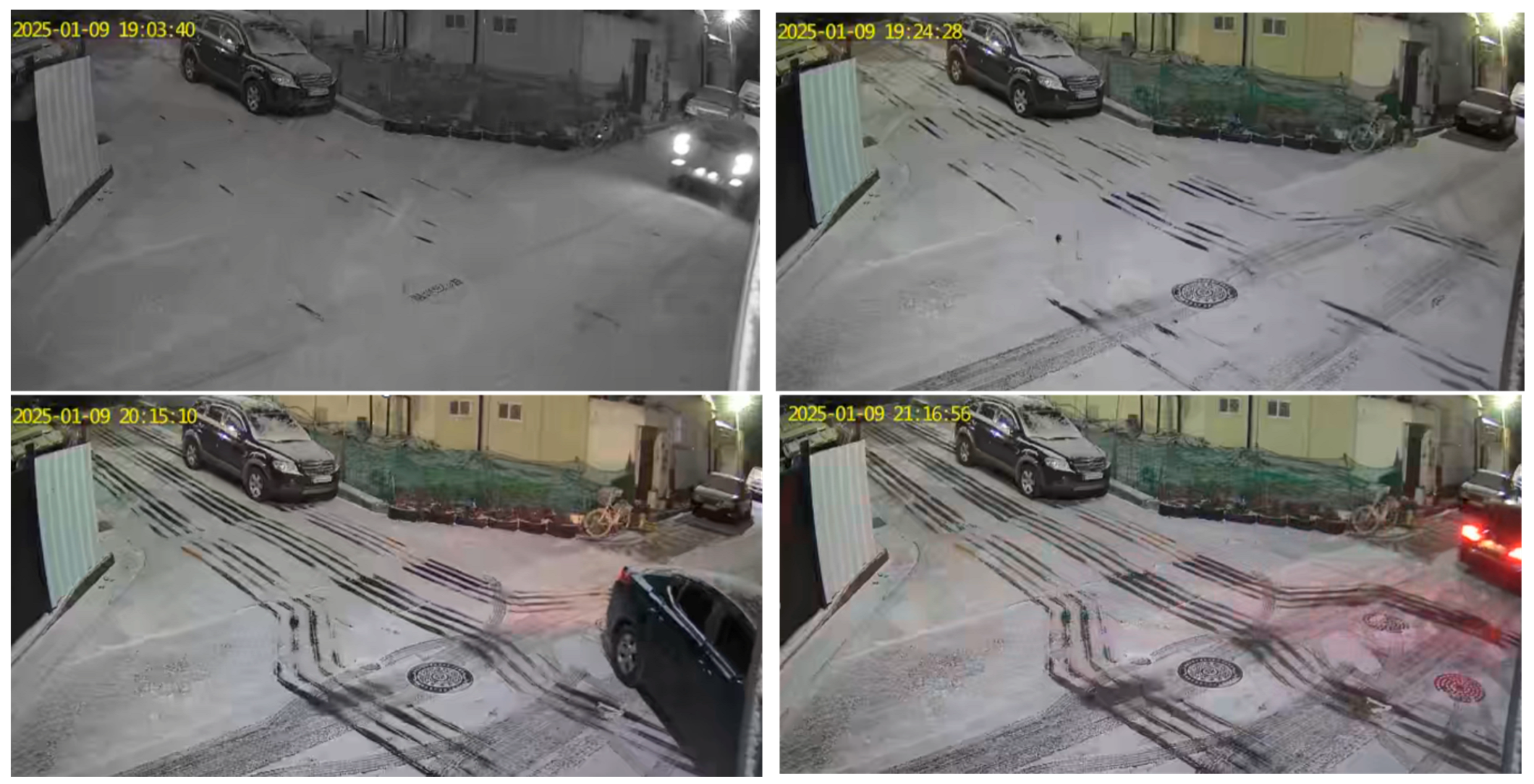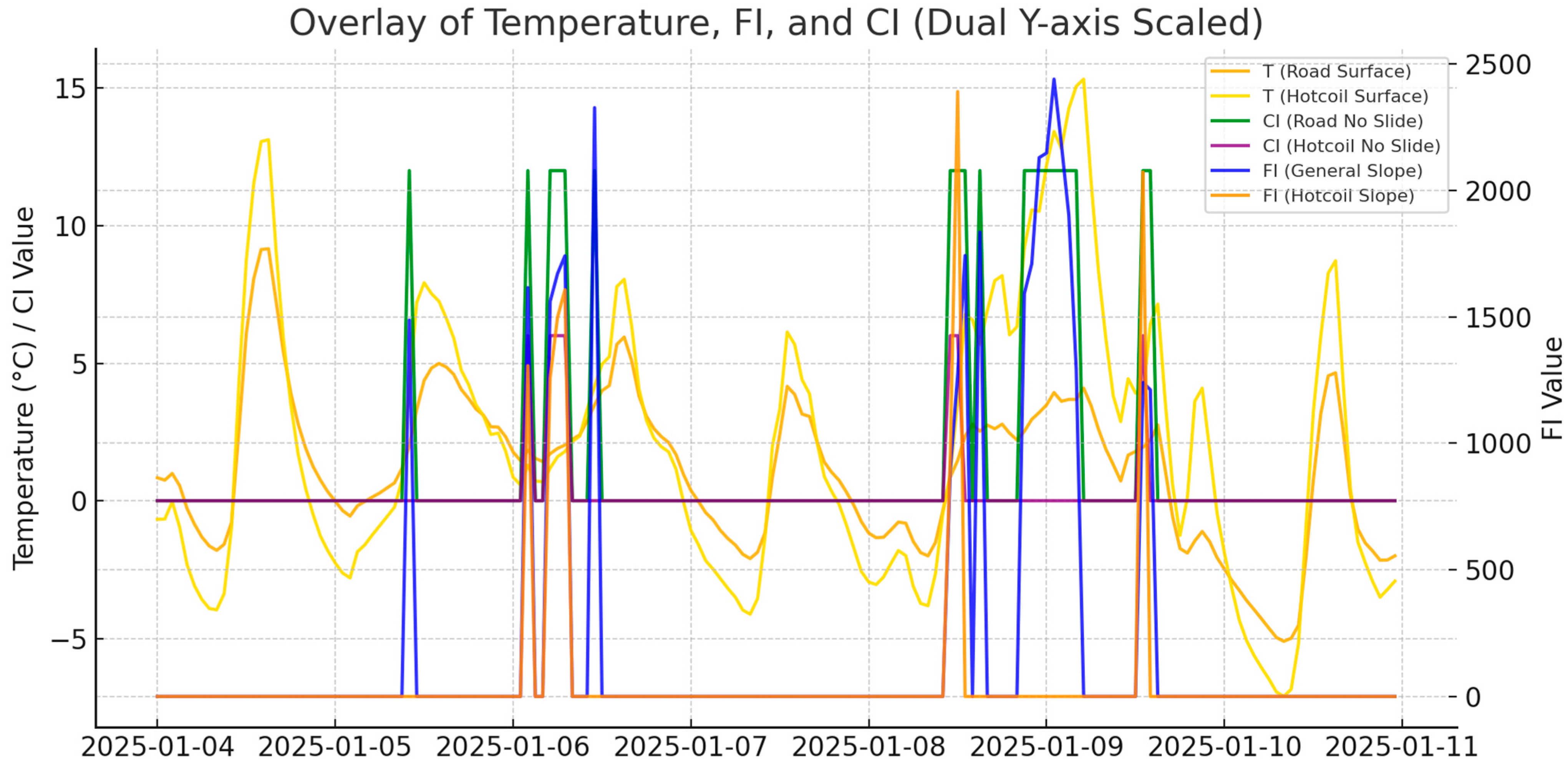1. Introduction
Winter road icing has emerged as a critical safety challenge in many urban areas, especially in regions increasingly affected by severe cold-season events due to climate change. Sloped urban roads are particularly vulnerable, creating hazardous conditions for both pedestrians and vehicles. In South Korea, the risks are especially acute for elderly residents, low-income households, and mobility-limited groups, who constitute a large proportion of winter-vulnerable populations. Conventional mitigation methods—such as de-icing salts and sand—are limited in effectiveness, environmentally harmful, and costly to maintain. As cities seek climate adaptation strategies, the need for systematic and quantitative approaches to assess and manage road icing risks has become urgent [
1,
2,
3].
Winter-road icing significantly increases accident risk and maintenance costs in cold regions. Conventional methods such as salt spreading and mechanical snow removal are often reactive, environmentally detrimental, and inefficient under fluctuating weather. Road Heating Systems (RHS) provide continuous preventive mitigation, yet a standardized evaluation framework for their operational performance remains limited. This study therefore proposes data-driven indices—Freezing Intensity (FI) and Cold Intensity (CI)—to quantify both icing risk and mitigation efficiency.
A representative case is Namgyeong-maeul Road in Daedeok-gu, Daejeon, which was selected as a pilot site for this study. The area is characterized by steep slopes exceeding 10%, dense residential development, and a high concentration of vulnerable groups, including the elderly and basic livelihood beneficiaries. Winter icing here frequently disrupts daily mobility and poses serious risks of slip-and-fall accidents as well as traffic collisions. Long-term climate data show that, despite the overall warming trend in South Korea, the frequency of extreme cold spells and snowfall events has increased, intensifying the risk of road icing. Socially, Daedeok-gu’s rising elderly population and limited emergency response capacity further amplify vulnerability, making the introduction of preventive infrastructure such as road heating systems (RHS) particularly urgent [
4,
5,
6]. An aerial perspective of the study area—including slope and residential clustering—appears in the site overview (
Figure 1).
Importantly, the RHS at Namgyeong-maeul Road was installed and operated by the Daejeon city government with financial support from the Korean Ministry of Environment. This study was conducted on the Namgyeong-maeul pilot slope, Daejeon, South Korea, within the municipal project ‘Winter Road Heating System Optimization’ (Project No. 2025-001-02). The Korea Environment Institute (KEI) was commissioned to conduct monitoring and evaluation of the system, deploying AWS, surface sensors, thermal imaging, drone surveys, and IP cameras to collect multi-modal real-world data [
7,
8,
9].
While thermal-comfort indices such as UTCI or PET assess human heat stress, this study focuses instead on operational indices that quantify pavement icing and mitigation efficiency [
10,
11,
12] (
Figure 2).
To address this gap, this study introduces two indices—
Freezing Intensity (FI) and
Cold Intensity (CI)—which were specifically developed and validated through a pilot monitoring project on Namgyeong-maeul Road (
Figure 1). FI quantifies the
potential for icing occurrence based on surface and meteorological conditions, while CI measures the
actual severity of icing by incorporating slope, sub-threshold temperatures, humidity, and heating operation. Both indices are grounded in formulas derived from field protocols, ensuring their applicability in real-world monitoring [
13,
14,
15].
The objectives of this study are threefold: (1) to evaluate the real-world performance of RHS in reducing icing risks on steep urban roads, (2) to establish FI and CI as quantitative indices that can serve as a winter-season equivalent to existing summer climate indices, and (3) to provide evidence-based insights for policy and engineering applications that enhance mobility safety for vulnerable populations.
Through this work, FI and CI are proposed as foundational constructs for winter climate adaptation science, offering policymakers, engineers, and researchers new tools to improve safety, resilience, and sustainability in cold-season urban environments.
2. Materials and Methods
2.1. Study Site
The field study was conducted on Namgyeong-maeul 3rd Road (Site A) in Daedeok-gu, Daejeon, South Korea, a steep residential slope with a length of approximately 70 m and an average gradient of 11.9%. This site was chosen because it represents the most hazardous segment among three RHS-installed locations, and it has a high frequency of winter icing accidents. The surrounding residential area is densely populated with elderly residents and vulnerable groups, making safe mobility during winter a critical social concern. A site overview image highlighting the steep slope and residential clustering is provided (
Figure 3).
Although Sites B and C were included in the overall project (
Winter Road Heating System Optimization, Project No. 2025-001-02; see Figure 1), only Site A was selected for quantitative FI and CI computation due to accessibility limitations [
16]. Sites B and C were used for supplementary qualitative verification through drone and IP camera observations. Representative imagery for these verification activities is presented later in the Results.
2.2. Monitoring Instruments and Data Collection
We deployed a layered system from December 2024 to January 2025: AWS (air temperature, RH, wind, precipitation, radiation), surface temperature loggers, thermal imaging, UAV/drone surveys, and IP cameras for time-lapse states [
7,
8,
9,
17,
18,
19]. The modular monitoring assembly mounted on the utility pole (including AWS, snow sensor, camera, and communications) is shown (
Figure 5). Sensor placement across the heated and reference sections with example thermal snapshots under RHS operation is illustrated (
Figure 6).
Automatic Weather Station (AWS, Ecowitt WS series): recorded air temperature, relative humidity, wind speed, precipitation, solar radiation, and UV index at 5 min intervals.
Surface Temperature Loggers (T&D TR-71WF): installed in both heated and reference lanes to measure pavement surface temperatures continuously.
Thermal Imaging (FLIR E6): daily infrared images for visualizing surface temperature differences and de-icing progress.
Drone Surveys (DJI Mini series): aerial imaging of Sites A–C after snowfall events to confirm de-icing effectiveness.
IP Cameras: real-time continuous monitoring of icing and de-icing states.
Key parameters and devices are summarized in
Table 1.
All sensors were networked to a cloud-based data server, with LTE communication modules for real-time transmission. The system remained operational throughout freezing conditions, with power backup and weather shielding. For this study, “freezing” was assumed when surface temperature was ≤4 °C with concurrent precipitation (or snowfall sensor ON); dew-point/RH thresholds were referenced for context. Operational criteria used for index computation are compiled.
Sensors: Ecowitt WS69 AWS, T&D TR-71WF data loggers, FLIR E6 thermal camera, drone-based thermal surveys.
Data Collection: Surface temperature, air temperature, humidity, wind speed, and recipitation were measured at 5 min intervals from December 2024 to January 2025.
Comparison: Heated vs. non-heated road sections.
2.3. Freezing Intensity (FI)
The Freezing Intensity (FI) index was developed to quantify the potential for road surface icing by integrating meteorological and surface variables. Following the project’s protocol formula, FI is expressed as
where
: freezing trigger function (1 if threshold conditions are met, 0 otherwise)
: instantaneous road surface temperature (°C)
: average surface temperature during the observation period (°C)
: average relative humidity (%)
: precipitation factor (snow/rain intensity and type)
: wind speed factor (m/s)
A schematic of the variables and data flows used to compute FI is provided (
Figure 7).
Table 2 summarizes FI–CI conceptual differences and is not a grading table, whereas FI interpretation follows the severity classification in
Table 3.
F: freezing occurrences counted from 5 min records within each hour when both precipitation is present (snow/rain) and the road surface temperature is ≤4 °C. T: total freezing duration per hour, derived from 5 min sampling (i.e., each counted occurrence corresponds to 5 min). : hourly average of road surface temperature at the icing site (°C). : hourly average relative humidity at the icing site (%). P: precipitation factor indicating the presence/intensity of snow/rain during the hour. W: wind factor indicating the presence/intensity of wind during the hour. Data are synchronized at 5 min intervals from AWS and surface loggers.
With
(trigger),
(surface °C),
,
,
,
> 1000 flags high icing potential [
13,
20]. FI is used as a probabilistic early-warning metric: higher FI means a higher likelihood of icing in the next hour and motivates proactive RHS activation (see the threshold classification,
Table 3). Differences between the predictive FI and the evaluative CI are summarized for quick reference (
Table 2).
The FI formula used in this study is a project-defined prototype index designed to predict icing potential from synchronized 5 min records (AWS and surface loggers). It counts freezing occurrences per hour when precipitation is present (snow/rain) and the road-surface temperature is ≤4 °C, and summarizes co-occurring humidity and wind factors for operational triggering.
2.4. Cold Intensity (CI)
The Cold Intensity (CI) index was formulated to measure the actual severity of icing conditions and the effectiveness of RHS operation. The project-defined formula is
where
: RHS operation factor (heating energy applied; kWh);
: slope coefficient (normalized by gradient; 1.0 for 10% slope);
, , , : as defined in formula;
Interpretation:
values greater than 2.0 represent hazardous icing severity, while lower values indicate successful mitigation through RHS activation [
13,
20]. A unified schematic for FI/CI variable linkages and monitoring layout is provided for reference (
Figure 7). CI interpretation follows the classification in
Table 3.
A: RHS operation factor reflecting heating application/energy during the hour (e.g., heater ON vs. reduced/idle), used to evaluate mitigation effectiveness. B: slope/road-condition coefficient representing site geometry (e.g., normalized by gradient for inclined sections); other symbols (F, T, P, W) follow the definitions in
Section 2.3. CI is a severity index that integrates the observed freezing frequency/duration with site conditions (slope) and operation state of the road-heating system. The coefficients A (RHS operation) and B (slope/road condition) are calibrated for the project (e.g., A = 1 for heated, 0.5 for non-heated; B = 1.0 flat, 0.8 slope). CI is suited for after-the-event evaluation: it quantifies residual icing severity and the effectiveness of RHS; larger CI implies greater hazard, as illustrated in the worked example
Figure 7.
Figure 7 Schematic of FI and CI computation with monitoring layout. An AWS provides air variables (precipitation, wind, humidity), while surface loggers measure pavement temperature at 5 min intervals in heated and reference sections. Variables used in Equations (1) and (2) are: F, T,
,
, P, W, A, B (see
Section 2.3 and
Section 2.4). Thermal/drone/IP-camera images are used to validate icing/de-icing states.
2.4.1. Theoretical Basis and Empirical Formulation of FI and CI
This subsection presents the theoretical basis and empirical formulation of the proposed FI and CI indices, detailing their physical interpretation, normalization procedure, and field implementation structure.
We operationalized FI and CI directly from field-measured signals with transparent transformations. This formulation follows established road-surface energy-balance and icing-prediction principles, where pavement temperature evolution results from radiative, convective, and conductive fluxes under meteorological forcing [
21,
22,
23,
24,
25,
26]. The freezing trigger (F) equals 1 when both (i) a hydrometeor signal is present (rain/snow) and (ii) the pavement temperature is below 4 °C; otherwise, F = 0. Temperature (T) enters as the road-surface temperature factor. Hydrometeor (P) and wind (W) contribute small additive multipliers (+0.1 each when present) to reflect observed persistence. The CI index incorporates the actual RHS power (A, kWh-based) and a slope coefficient (B) defined by slope class: B = 0.8 for ‘slide’ (sloped) and B = 1.0 for ‘no-slide’ (flat). Empirically, sloped (“slide”) segments exhibited greater icing persistence and required higher heating power to maintain equivalent safety. Therefore, placing B in the denominator ensures that, for identical meteorological and operational conditions, sloped segments (smaller B) yield larger CI values, realistically representing higher residual risk.
The slope coefficient (B) was normalized by setting the flat surface as the reference condition (B = 1.0) and assigning smaller values approaching zero for steeper slopes (e.g., B = 0.8 for “slide”). This normalization concept aligns with prior road-icing models that incorporated topographic slope and drainage efficiency to predict prolonged freeze duration on inclined surfaces [
22,
24,
26]. This enables intuitive interpretation: as the slope becomes steeper and drainage efficiency decreases, B approaches 0, which increases CI in the denominator structure of Equation (2). This scaling approach maintains dimensional consistency while reflecting the physical instability of sloped surfaces.
Accordingly, Equations (1) and (2) were developed. The formulation follows established energy-balance and road-icing prediction principles [
21,
22,
23,
24,
25,
26], where surface temperature is governed by radiative, convective, and conductive fluxes, in combination with meteorological forcing such as precipitation, wind, and slope drainage.
In this study, the RHS operation factor A was dimensionally defined as a continuous power term (kWh), but for the current empirical implementation, it was represented as a simplified binary scalar (1.0 for ON, 0.5 for partial/standby). The treatment of A as a heating-power term is consistent with previous energy-balance simulations for heated or insulated pavements, where thermal input directly modifies conductive and latent heat fluxes [
23,
25,
26]. This approach preserves dimensional consistency while facilitating operational clarity and initial field validation. In future studies, A will be reintroduced as a continuous variable to capture finer energy–risk interactions and to enhance model scalability across multiple sites.
This simplified form is therefore an abbreviated empirical model, intentionally constructed to enable field implementation and future refinement as multi-site datasets become available. Such simplified yet physically interpretable formulations are consistent with prior empirical–theoretical studies on winter-road thermodynamics [
21,
22,
23,
24,
25,
26]. The structure is identical to the collected environmental data pipeline (4–10 January data), and
Appendix A Table A1 lists the column-to-symbol mapping and cell formulas.
2.5. FI–CI Comparative Framework
FI and CI complement each other: FI acts as a predictive trigger for pre-event RHS activation, while CI serves as an evaluative indicator for post-event severity and effectiveness of mitigation [
13,
20,
27]. Their comparative features are condensed in a side-by-side framework (
Table 4).
2.6. Freezing Condition Criteria
To operate the indices, freezing was assumed when the following conditions were satisfied:
Road surface temperature ≤ 4 °C, and Precipitation (rain/snow) ≥ 1 mm/h or presence of snowfall sensor signal dew point and RH thresholds modulate risk [
28,
29]. The criteria and contributing factors used in this study are summarized (
Table 5).
2.7. Data Processing and Analysis
To transform raw environmental and operational data into standardized analytical form, all datasets were synchronized and pre-processed before computing the proposed indices. This subsection summarizes the data-handling workflow, from time-series alignment and FI/CI computation to validation and comparative gap analysis between heated and reference lanes.
Five-minute resolution; synchronized streams; FI/CI computed for both lanes; thermal/UAV/IP-camera cross-verification; gap analysis (heated vs. reference) [
17,
18,
19,
27].
Resolution: All data were recorded at 5 min intervals, synchronized across AWS and loggers.
Computation: FI and CI values were calculated for both heated and reference lanes throughout the study period.
Validation: Indices were cross-verified with thermal images, drone surveys, and CCTV footage to confirm actual icing and de-icing.
Gap Analysis: FI and CI gaps (heated vs. reference) were calculated to quantify the improvement due to RHS installation. The end-to-end workflow—computation, validation, and gap analysis—is depicted (
Figure 8).
Both FI and CI are project-specific operational indices proposed for this pilot; they are not adopted from prior literature verbatim and therefore require site/season calibration before wider deployment.
3. Results
Continuous monitoring of Site A (Namgyeong-maeul 3rd Road, Daedeok-gu, Daejeon) from 17 December 2024 to 14 January 2025 revealed substantial differences between the heated and reference road sections. Results are presented in five categories: (1) surface temperature comparison, (2) thermal/drone/IP camera verification, (3) FI analysis, (4) CI analysis, and (5) integrated gap evaluation.
Across the study period, all data streams (surface loggers, AWS, thermal images, UAV, and IP cameras) consistently indicated superior thermal performance and de-icing behavior in the heated lane. An overview of these multi-source results is visualized across the comparative time series and imaging panels (
Figure 9,
Figure 10,
Figure 11,
Figure 12,
Figure 13 and
Figure 14) and summarized in tables (
Table 6,
Table 7 and
Table 8).
3.1. Surface Temperature Comparison
The heated section (RHS applied) consistently maintained higher surface temperatures compared to the untreated reference.
The average surface temperature in the heated section was 4.1 °C higher than the reference.
During peak cold events, the maximum difference exceeded 12.5 °C, and the minimum temperature gap was ~5.3 °C.
The reference section frequently dropped below 0 °C, sustaining icy conditions, while the heated section remained consistently above freezing [
13,
15,
27].
These patterns are confirmed by the lane-level surface temperature time series (
Figure 9) and corroborated by thermal imaging contrasts between the two sections (
Figure 10).
3.2. Thermal Imaging and Drone Verification
Beyond numerical evaluation, independent visual verification was conducted to confirm the real-world effectiveness of the road-heating system. This subsection presents thermal, drone, and IP-camera evidence that complements the quantitative FI/CI analysis by documenting on-site icing, melting, and recovery dynamics.
Independent monitoring further validated quantitative observations.
Thermal images (
Figure 10) showed rapid de-icing of heated segments within hours after snowfall, while the reference lane remained frozen [
17,
18].
Drone surveys (
Figure 11) validated that heated Site A maintained mobility, whereas untreated Sites B and C exhibited persistent icing [
19].
IP camera monitoring (
Figure 12) provided time-lapse visual confirmation of de-icing effectiveness, with progressive reduction in slip risk [
30,
31].
A representative time-lapse sequence documenting the transition from icing to complete melting is summarized in the status-change table (
Table 6).
3.3. Freezing Intensity (FI) Results
The FI index successfully captured differences in icing risk between the two sections. In the reference lane, FI values peaked at 2439 during extreme cold events (classified as “very dangerous”), while the heated lane remained consistently near 0, indicating almost complete elimination of icing potential [
13,
20].
Figure 13 illustrates the time-series FI trends for Site A from 17 December 2024, to 14 January 2025. Peaks in the reference lane aligned with snowfall and sub-zero conditions, whereas the heated lane showed suppressed values throughout the same period.
Notably, FI in the heated lane exceeded the reference in Cases ② and ③ (2390 vs. 1270 at 12:00 on 8 January; 2072 vs. 1239 at 13:00 on 9 January), as shown in
Table 7. This counter-intuitive peak arises from two characteristics of the prototype FI: (i) hourly accumulation of 5 min freezing triggers and duration, and (ii) multiplication by the hourly mean surface-temperature term while the freezing trigger requires only that the surface be ≤4 °C with precipitation. When precipitation is present and the heated surface briefly hovers just below 4 °C early in the hour, FI can be inflated relative to a colder reference lane because the same triggers are counted but the hourly temperature multiplier is larger on the heated surface. In these two cases, de-icing commenced within the same hour (partial → full melting), so the hourly FI captured early-hour triggers but not the subsequent clearance, further elevating the heated-lane FI. Elevated relative humidity in Case ② also amplified FI through the humidity term. By contrast, CI—which incorporates RHS operation and slope—remained lower in the heated lane (6 vs. 12 in both Cases ② and ③), correctly reflecting reduced on-site severity. Accordingly, the anomaly analysis supports using CI as a complementary severity metric when FI shows short-lived, precipitation-driven spikes (
Figure 13;
Table 7).
3.4. Cold Intensity (CI) Results
CI provided complementary evaluation of the severity of icing and the effectiveness of RHS operation. The reference lane frequently reached values around 12, representing severe icing hazards, while the heated lane consistently remained below 6, demonstrating a reduction in icing severity by more than 50% [
13,
20,
27].
Figure 14 presents the CI time-series between 4 January and 10 January 2025. This period includes several icing events where RHS activation significantly reduced CI values compared to the untreated reference.
These CI patterns reflect reduced residual hazard in the heated lane during and after cold events, aligning with the temperature and image-based observations. The lane-differentiated CI trajectories and event windows are detailed in the time series (
Figure 14).
Quantitatively, FI decreased from an average of 234.4 to 76.4 and CI from 2.07 to 0.36 during the 4–10 January event window.
This corresponds to a reduction of approximately 50% in residual icing duration and severity, derived from the ratio of mean values and confirmed by the time-series overlay (
Figure 15).
The RHS-heated section achieved rapid post-event recovery with CI values confined to 0–6, while the reference lane remained at 6–12 for comparable periods, validating the observed 50% improvement in operational responsiveness.
3.5. Gap Analysis of Heated vs. Reference Sections
Quantitative gap analysis demonstrated RHS effectiveness:
For reporting, gaps are expressed as (Reference−Heated) for the same hour; positive values indicate advantage of RHS operation. Summary statistics for FI and CI gaps are provided in the comparative table (
Table 8).
The “≈50% reduction” was computed from the relative difference between the mean FI and CI values of heated and non-heated segments (FI: 234.4 → 76.4; CI: 2.07 → 0.36). In addition, the observed duration of residual icing after RHS activation was roughly halved in time-lapse records (
Table 6), confirming a 50% improvement in melting response and safety recovery speed.
3.6. Integrated Comparison of Heated vs. Non-Heated Segments (4–10 January 2025)
Heated section: Maintained average surface temperature at ~7 °C, peaking at 12.5 °C.
Non-heated section: Averaged only 2 °C, dropping to −2.5 °C.
FI values: Heated avg. 76.4 (max 2390.5) vs. Non-heated avg. 234.4 (max 2439.5).
CI values: Heated avg. 0.36 (max 7.5) vs. Non-heated avg. 2.07 (max 15.0).
Taken together, the heated lane maintained warmer surfaces, lower FI/CI levels, and faster recovery following snowfall, whereas the untreated lane showed persistent sub-zero periods and higher residual risk. Together, these results confirm that RHS operation significantly reduced both icing potential (FI) and severity (CI), providing robust improvements in winter road safety [
27]. These integrated findings synthesize the temperature observations, index time series, and imaging evidence presented above (
Figure 9,
Figure 10,
Figure 11,
Figure 12,
Figure 13 and
Figure 14;
Table 6,
Table 7 and
Table 8).
3.7. Integrated Comparison of Heated vs. Non-Heated Segments Using FI and CI (4–10 January 2025)
To visually evaluate the performance of FI and CI against simple temperature-based indicators, a time-series overlay (
Figure 15) was prepared for 4–10 January 2025. The plot shows that FI peaks immediately before freezing onset, while CI declines after RHS activation, particularly at ‘no-slide’ (flat) segments. This two-phase behavior confirms that FI acts as a predictive trigger and CI serves as a severity evaluator reflecting post-heating recovery. The heated lane maintained consistently lower CI values (≈0–6) compared with the non-heated reference (≈6–12), indicating more than a 50% reduction in icing severity. These findings demonstrate that the FI/CI framework provides clearer and more actionable guidance than temperature-only monitoring by capturing both the onset and mitigation stages of road-icing dynamics.
Dual Y-axes indicate surface temperature (°C, left) and FI value (right). FI peaks immediately before freezing onset, while CI decreases following RHS activation (A = 1.0), particularly at “no-slide” (flat) segments (B = 1.0).
This pattern confirms the coupled dynamics between T, FI, and CI, illustrating that FI captures the pre-freezing trigger phase and CI reflects post-heating mitigation effectiveness.
4. Discussion
The dual structure of FI and CI offers both predictive capability (FI as an early-warning trigger) and evaluative capability (CI as a severity measure), making them the first structured indices for standardized winter road safety assessment [
10,
11,
12,
13,
20,
27]. This pairing gives operators both a forward-looking trigger and a backward-looking check on residual risk. Beyond academic contribution, these indices provide actionable thresholds for policymakers and engineers to optimize RHS operation, minimize energy costs, and safeguard vulnerable populations. In practice, FI supports proactive activation, while CI confirms whether mitigation has actually reduced on-site hazard.
4.1. Significance of FI and CI as Winter Climate Indices
This study proposed two novel indices—Freezing Intensity (FI) and Cold Intensity (CI)—that create a quantitative framework for winter road icing risk assessment. The framework turns heterogeneous sensor streams into consistent, hour-by-hour indicators. Unlike conventional binary classifications of “frozen” vs. “non-frozen,” FI and CI enable continuous, data-driven monitoring. This enables graded responses rather than all-or-nothing interventions.
FI captured the probability of icing occurrence, with reference sections exceeding values of 2400 (classified as very dangerous), while heated sections remained near zero.
CI measured the actual severity of icing, with untreated sections reaching ~12, compared to heated sections consistently below 6.
This dual framework represents a substantial step forward in winter climate adaptation science by coupling proactive prediction with post-event evaluation. Together, they provide an integrated basis for operations, reporting, and safety communication.
4.2. Comparison with Existing Climate Indices
The FI/CI framework directly informs roadway safety operations rather than human comfort evaluation. These tools anchor standards and automate responses. However, until now, no equivalent standardized indices existed for winter icing hazards. FI and CI fill this gap by offering [
10,
11,
12]:
Predictive capability (FI): analogous to threshold-based activation metrics in heat studies, FI provides data-driven triggers for RHS activation (e.g., FI > 1000).
Evaluative capability (CI): comparable to heat stress indices, CI quantifies the residual risk of icing, supporting real-time management and post-event safety validation.
This positioning is summarized in the conceptual framework contrasting summer and winter indices (
Figure 2) and is operationalized through the FI/CI comparison table (
Table 2).
By establishing FI and CI as complementary indices, this study provides a seasonally balanced framework, aligning winter hazard assessment with existing summer-focused approaches. This symmetry helps cities integrate winter safety into existing climate dashboards and SOPs. The practicality of this alignment is illustrated by the observed improvements in surface temperature and indices under RHS operation (
Figure 9,
Figure 10,
Figure 11,
Figure 12,
Figure 13 and
Figure 14).
4.3. Policy and Engineering Implications
Results from Site A demonstrated clear benefits of RHS installation, where FI dropped from >2400 to nearly zero and CI was reduced by more than 50%. These outcomes generalize into actionable rules for operation and investment. These outcomes highlight several implications:
Taken together, these points support policy adoption (threshold setting), operational automation, and transparent evaluation of RHS effectiveness.
4.4. Limitations and Future Directions
Despite promising results, several limitations remain. These limitations guide next steps for validation and deployment.
Temporal scope: Monitoring was limited to a single winter season (December 2024–January 2025), requiring multi-year data to validate the robustness of FI and CI.
Geographic scope: Quantitative analysis was limited to Site A, while Sites B and C provided only qualitative verification. Broader testing across diverse terrains is necessary.
Formula refinement: FI and CI were derived from project protocols rather than international standards; calibration with larger, multi-regional datasets will enhance universality.
Integration with existing models: Linking FI and CI with weather forecasts, pavement condition monitoring, and traffic safety models could further improve accuracy and operational value.
Future research should extend the spatial and temporal scope, refine formulas with expanded datasets, and integrate FI/CI into smart infrastructure and climate-resilient city planning. This roadmap will help standardize the indices and embed them in routine winter operations.
4.5. Overall Contribution
By bridging the gap between meteorological conditions and road safety outcomes, FI and CI advance the scientific understanding of winter road hazards and provide a practical toolset for municipalities. Together, they represent the first structured indices capable of quantifying both the likelihood and severity of road icing. As such, FI and CI form a foundational toolset for winter climate adaptation, enhancing urban resilience, mobility safety, and sustainable infrastructure management. In sum, the indices convert multi-sensor observations into operational decisions, enabling safer, more efficient winter road management.
5. Conclusions
This study introduced and validated two novel indices—Freezing Intensity (FI) and Cold Intensity (CI)—to quantitatively evaluate road icing risks and the effectiveness of Road Heating Systems (RHS). Field monitoring conducted at Namgyeong-maeul 3rd Road in Daedeok-gu, Daejeon, South Korea, from December 2024 to January 2025 revealed the following key findings:
Surface temperature improvement: RHS installation increased average pavement surface temperature by 4.1 °C compared to the reference lane, with maximum differences exceeding 12.5 °C during extreme cold events.
Reduction in icing potential (FI): Reference lanes reached FI values up to 2439 (classified as very dangerous), while heated lanes consistently remained near zero, indicating near-complete elimination of icing risk.
Mitigation of icing severity (CI): Untreated lanes recorded CI values around 12–15, while heated lanes remained below 6, demonstrating a >50% reduction in icing severity.
Quantitative gap analysis: FI Gaps exceeded 2000, and CI Gaps averaged 6–8 points, providing clear numerical evidence of RHS effectiveness. Together, these findings show consistent thermal uplift, suppressed icing potential, and lower residual severity where RHS is installed.
Importantly, the RHS system at Namgyeong-maeul Road was installed and operated by the Daejeon city government with financial support from the Korean Ministry of Environment under a national program targeting climate-vulnerable neighborhoods. The Korea Environment Institute (KEI) conducted independent monitoring and evaluation, using AWS, surface loggers, thermal imaging, drone surveys, and IP cameras to ensure comprehensive, multi-modal assessment. This governance and auditing arrangement strengthens the credibility and transferability of results.
The dual structure of FI and CI offers both predictive capability (FI as an early-warning trigger) and evaluative capability (CI as a severity measure). Together, they represent the first structured indices for winter road safety assessment, filling a critical gap that has long existed compared to summer indices such as UTCI, PET, and PMV. In practice, FI informs proactive activation thresholds, while CI validates on-site effectiveness and residual risk.
Beyond academic contribution, FI and CI provide actionable thresholds for policymakers and engineers to
Establish data-driven activation guidelines for RHS operation;
Conduct cost–benefit analyses of winter road safety infrastructure, and
safeguard vulnerable populations in climate-exposed urban neighborhoods.
These applications enable evidence-based standard operating procedures and transparent reporting.
Future research should expand validation across multiple winter seasons and diverse geographic contexts, refine formulas with larger datasets, and integrate FI/CI into smart infrastructure platforms combining IoT and AI.
Priority areas include multi-year calibration, cross-site benchmarking, and coupling with operational forecasting.
By establishing FI and CI as foundational tools for winter climate adaptation science, this study contributes to urban resilience, climate-smart mobility, and sustainable infrastructure management.
Author Contributions
Conceptualization, Y.-S.L. and T.K.K.; methodology, T.H.K. and Y.-S.L.; software, T.K.K.; validation, T.K.K.; formal analysis, Y.-S.L.; investigation, T.H.K.; resources, T.H.K.; data curation, Y.-S.L.; writing—original draft preparation, T.K.K.; writing—review and editing, Y.-S.L. and T.K.K.; visualization, T.K.K.; supervision, T.K.K. and T.H.K. All authors have read and agreed to the published version of the manuscript.
Funding
This paper is based on the results of the research work “Local Government Climate Adaptation and Vulnerability Improvement Project” (2025-001-02), conducted by the Korea Environment Institute (KEI) upon the request of the Korea Ministry of Climate, Energy, Environment.
Data Availability Statement
Restrictions apply to the datasets. Due to institutional ownership, raw data are not publicly available, but processed results are presented within the manuscript. Additional details may be provided by the corresponding authors upon reasonable request.
Conflicts of Interest
Author Tae Kyung Kwon was employed by the company AIRPLE Co., Ltd. The remaining authors declare that the research was conducted in the absence of any commercial or financial relationships that could be constructed as a potential conflict of interest.
Abbreviations
The following abbreviations are used in this manuscript:
| AWS | Automatic Weather Station |
| RHS | Road Heating System |
| FI | Freezing Intensity |
| CI | Cold Intensity |
| UTCI | Universal Thermal Climate Index |
| PET | Physiological Equivalent Temperature |
| PMV | Predicted Mean Vote |
| KEI | Korea Environment Institute |
| IoT | Internet of Things |
| UAV | Unmanned Aerial Vehicle (Drone) |
| FLIR | Forward Looking Infrared (thermal imaging camera) |
| kWh | Kilowatt-hour |
| RH | Relative Humidity |
References
- Fay, L.; Shi, X. Environmental impacts of chemicals for snow and ice control: State of the knowledge. Cold Reg. Sci. Technol. 2012, 67, 119–129. [Google Scholar] [CrossRef]
- Shi, X.; Akin, M.; Pan, T.; Fay, L.; Liu, Y.; Yang, Z. Deicer impacts on pavement materials: Introduction and recent developments. Open Civ. Eng. J. 2009, 3, 16–27. [Google Scholar] [CrossRef]
- Błażejczyk, K.; Epstein, Y.; Jendritzky, G.; Staiger, H.; Tinz, B. Comparison of UTCI to selected thermal indices. Int. J. Biometeorol. 2012, 56, 515–535. [Google Scholar] [CrossRef]
- Jendritzky, G.; de Dear, R.; Havenith, G. UTCI—Why another thermal index? Int. J. Biometeorol. 2012, 56, 421–428. [Google Scholar] [CrossRef] [PubMed]
- Matzarakis, A.; Mayer, H.; Iziomon, M.G. Applications of a universal thermal index: Physiological equivalent temperature. Int. J. Biometeorol. 1999, 43, 76–84. [Google Scholar] [CrossRef] [PubMed]
- Rahman, M.L.; Malakooti, A.; Ceylan, H.; Kim, S.; Taylor, P.C. A review of electrically conductive concrete heated pavement system technology: From the laboratory to the full-scale implementation. Constr. Build. Mater. 2022, 329, 127139. [Google Scholar] [CrossRef]
- Qi, C.; Tang, J.; Fan, F.; Yan, Y. Effects of magnetic field on thermo-hydraulic behaviors of magnetic nanofluids in CPU cooling system. Appl. Therm. Eng. 2020, 179, 115717. [Google Scholar] [CrossRef]
- Jiang, C.; Zheng, J.; Liu, J.; Wu, L.; Yang, J. Studies review of the technology for snow and ice control for winter road maintenance. In Proceedings of the International Conference on Transportation Engineering (ICTE 2011), Chengdu, China, 23–25 July 2011; pp. 3245–3254. [Google Scholar]
- Tuan, C.Y. Conductive Concrete for Bridge Deck Deicing. In Concrete Technology Today; Portland Cement Association (PCA): Washington, DC, USA, 2004; Volume 25, pp. 1–4. Available online: https://www.academia.edu/52379174/Conductive_Concrete_for_Bridge_Deck_Deicing (accessed on 27 September 2025).
- Jónsson, P.; Riehm, M. Infrared thermometry in winter road maintenance. J. Atmos. Oceanic Technol. 2012, 29, 846–856. [Google Scholar] [CrossRef]
- Zhao, Y.; Zhang, J.; Li, L.; Hu, T.; Zhao, Y. Analytical solution for the temperature field of an elliptical tunnel in cold regions. Cold Reg. Sci. Technol. 2023, 208, 103793. [Google Scholar] [CrossRef]
- Ranyal, E.; Sadhu, A.; Jain, K. Road condition monitoring using smart sensing and artificial intelligence: A review. Sensors 2022, 22, 3044. [Google Scholar] [CrossRef] [PubMed]
- Grabowski, D.; Czyżewski, A. System for monitoring road slipperiness based on CCTV cameras and convolutional neural networks. J. Intell. Inf. Syst. 2020, 55, 521–534. [Google Scholar] [CrossRef]
- Khan, M.N.; Ahmed, M.M. Weather and surface condition detection based on road-side webcams: Application of pre-trained convolutional neural network. Int. J. Transp. Sci. Technol. 2022, 11, 468–483. [Google Scholar] [CrossRef]
- Johnston, J.M.; Jacobs, J.M.; Hunsaker, A.; Wagner, C.; Vardaman, M. Applications of snow-covered areas from unoccupied aerial systems (UAS) visible imagery: A demonstration in southeastern New Hampshire. Remote Sens. 2025, 17, 1885. [Google Scholar] [CrossRef]
- Boselly, S.E.; Thornes, J.; Ulberg, C.; Ernst, D. Road Weather Information Systems, Volume I. Strategic Highway Research Program Publication SHRP-H-350; National Research Council: Washington, DC, USA, 1993; pp. 90–93.
- Tabrizi, S.E.; Xiao, K.; Thé, J.V.G.; Saad, M.; Farghaly, H.; Yang, S.X.; Gharabaghi, B. Hourly road pavement surface temperature forecasting using deep learning models. J. Hydrol. 2021, 603, 126877. [Google Scholar] [CrossRef]
- Anis, M.; Abdel-Raheem, M. A review of electrically conductive cement concrete pavement for sustainable snow-removal and deicing: Road safety in cold regions. Transp. Res. Rec. 2024, 2678, 50–71. [Google Scholar] [CrossRef]
- Ruuhela, R.; Hippi, M.; Hartonen, S. Pedestrian wintertime slip and fall injuries—Effectiveness of weather warning service in prevention. Scand. J. Public Health 2025, 53, 142–148. [Google Scholar] [CrossRef]
- Tarcea, A.; Vergouwen, M.; Sayre, E.C.; White, N.J. The Slip and Fall Index: Assessing the risk of slipping and falling on ice. Can. J. Public Health 2024, 115, 296–304. [Google Scholar] [CrossRef]
- Jang, J. Night icing prediction using vehicle-mounted pavement temperature sensor and atmospheric data. Transp. Res. Interdiscip. Perspect. 2023, 21, 100910. [Google Scholar] [CrossRef]
- Sass, B.H. A numerical model for prediction of road temperature and ice. J. Appl. Meteorol. Climatol. 1992, 31, 1499–1506. [Google Scholar] [CrossRef]
- Hu, Y.; Almkvist, E.; Gustavsson, T.; Bogren, J. Modeling road surface temperature from air temperature and geographical parameters—Implication for the application of floating Car data in a road weather forecast model. J. Appl. Meteorol. Climatol. 2019, 58, 1023–1038. [Google Scholar] [CrossRef]
- Kangas, M.; Heikinheimo, M.; Hippi, M. RoadSurf: A modelling system for predicting road weather and road surface conditions. Meteorol. Appl. 2015, 22, 544–553. [Google Scholar] [CrossRef]
- Shao, J.; Lister, P.J. An automated nowcasting model of road surface temperature and state for winter road maintenance. J. Appl. Meteorol. 1996, 1352–1361. [Google Scholar] [CrossRef]
- Chen, L.; Voss, C.I.; Fortier, D.; McKenzie, J.M. Surface energy balance of sub-Arctic roads with varying snow regimes and properties in permafrost regions. Permafr. Periglac. Processes 2021, 32, 681–701. [Google Scholar] [CrossRef]
- Jiao, W.; Sha, A.; Liu, Z.; Jiang, W.; Hu, L.; Qin, W. Analytic investigations of snow melting efficiency and temperature field of thermal conductive asphalt concrete combined with electrical-thermal system. J. Clean. Prod. 2023, 399, 136622. [Google Scholar] [CrossRef]
- Zhang, W.; Dong, S.; Song, Z.; Ding, S.; Yi, J.; Han, B. Snow-melting performance and application method of stainless steel wires-modified conductive asphalt concrete based on electrothermal conversion. Appl. Therm. Eng. 2025, 269, 126066. [Google Scholar] [CrossRef]
- Lim, H.; Lee, S.; Lee, J. Effective snow removal devices for road pavement using geothermal heat pipe. Appl. Therm. Eng. 2025, 265, 125624. [Google Scholar] [CrossRef]
- Chen, X.; Huang, G.; Li, Q.; Yang, C. A novel geothermal pavement ice and snow melting system with reversible loop heat pipes to eliminate underground thermal imbalance. Appl. Therm. Eng. 2025, 269, 126052. [Google Scholar] [CrossRef]
- Murray, D.; Ernst, U.F. An Economic Analysis of the Environmental Impact of Highway Deicing; US Environ. Prot. Agency Report, Office of Research and Development, Municipal Environmental Research Laboratory: Washington, DC, USA, 1976.
Figure 1.
Aerial view of Namgyeong-maeul Road in Daedeok-gu, Daejeon.
Figure 1.
Aerial view of Namgyeong-maeul Road in Daedeok-gu, Daejeon.
Figure 2.
Conceptual research diagram of this study.
Figure 2.
Conceptual research diagram of this study.
Figure 3.
Heated road surface with embedded RHS coils at Namgyeong-maeul Road (4 November 2024).
Figure 3.
Heated road surface with embedded RHS coils at Namgyeong-maeul Road (4 November 2024).
Figure 4.
(a) Aerial context of Site A showing the monitored slope (~70 m, ~11.9%) and the locations of the heated section (H2, “Heat coil”) and the adjacent non-heated reference section (H1, “Non applied”); dashed arrows indicate the downhill direction and the approximate camera lines-of-sight from the pole. (b) Oblique drone view at street level marking the exact positions of surface-temperature sensors in H2 (heated lane) and H1 (reference lane), together with the two fixed cameras (C1, C2) used for time-lapse verification; the intersection geometry and curb line clarify where de-icing initiates and propagates across the carriageway.
Figure 4.
(a) Aerial context of Site A showing the monitored slope (~70 m, ~11.9%) and the locations of the heated section (H2, “Heat coil”) and the adjacent non-heated reference section (H1, “Non applied”); dashed arrows indicate the downhill direction and the approximate camera lines-of-sight from the pole. (b) Oblique drone view at street level marking the exact positions of surface-temperature sensors in H2 (heated lane) and H1 (reference lane), together with the two fixed cameras (C1, C2) used for time-lapse verification; the intersection geometry and curb line clarify where de-icing initiates and propagates across the carriageway.
Figure 5.
(a) Street-level view at Site A indicating the camera line-of-sight across the heated (H2, “Heat coil”) and reference (H1, “Non applied”) sections; dashed guides show the downhill direction and the baseline used for time-lapse verification. (b) Environmental monitoring system mounted on the Site A utility pole, labeling C1 = fixed camera, A1 = AWS (automatic weather station), S1 = snow sensor, Sol = solar panel, and W1 = Wi-Fi/LTE gateway for power and real-time telemetry.
Figure 5.
(a) Street-level view at Site A indicating the camera line-of-sight across the heated (H2, “Heat coil”) and reference (H1, “Non applied”) sections; dashed guides show the downhill direction and the baseline used for time-lapse verification. (b) Environmental monitoring system mounted on the Site A utility pole, labeling C1 = fixed camera, A1 = AWS (automatic weather station), S1 = snow sensor, Sol = solar panel, and W1 = Wi-Fi/LTE gateway for power and real-time telemetry.
Figure 6.
Placement of surface temperature sensors in heated (H2) and reference (H1) sections, with thermal snapshots during RHS operation.
Figure 6.
Placement of surface temperature sensors in heated (H2) and reference (H1) sections, with thermal snapshots during RHS operation.
Figure 7.
Schematic diagram of FI and CI formulas with monitoring components.
Figure 7.
Schematic diagram of FI and CI formulas with monitoring components.
Figure 8.
Workflow diagram of FI and CI calculation, validation, and gap analysis.
Figure 8.
Workflow diagram of FI and CI calculation, validation, and gap analysis.
Figure 9.
Comparison of surface temperatures between heated and reference Sections (1–14 January 2025).
Figure 9.
Comparison of surface temperatures between heated and reference Sections (1–14 January 2025).
Figure 10.
Thermal camera verification of heated vs. reference segments.
Figure 10.
Thermal camera verification of heated vs. reference segments.
Figure 11.
Drone-based monitoring of Sites A–C illustrating differences in de-icing effectiveness.
Figure 11.
Drone-based monitoring of Sites A–C illustrating differences in de-icing effectiveness.
Figure 12.
IP camera-based monitoring of Sites A–C illustrating differences in de-icing effectiveness.
Figure 12.
IP camera-based monitoring of Sites A–C illustrating differences in de-icing effectiveness.
Figure 13.
Time-series of FI values for heated (Hotcoil) and reference (Road) sections at Site A, Namgyeong-maeul 3rd Road, Daejeon (17 December 2024–14 January 2025). The circled numbers (①–③) indicate the time frames corresponding to the cases listed in
Table 7, showing the meteorological conditions during FI abnormal peaks.
Figure 13.
Time-series of FI values for heated (Hotcoil) and reference (Road) sections at Site A, Namgyeong-maeul 3rd Road, Daejeon (17 December 2024–14 January 2025). The circled numbers (①–③) indicate the time frames corresponding to the cases listed in
Table 7, showing the meteorological conditions during FI abnormal peaks.
Figure 14.
Time-series of CI values for heated (Hotcoil) and reference (Road) sections at Site A, Namgyeong-maeul 3rd Road, Daejeon (4–10 January 2025).
Figure 14.
Time-series of CI values for heated (Hotcoil) and reference (Road) sections at Site A, Namgyeong-maeul 3rd Road, Daejeon (4–10 January 2025).
Figure 15.
Overlay of surface temperature (T), freezing intensity (FI), and cold intensity (CI) during 4–10 January 2025.
Figure 15.
Overlay of surface temperature (T), freezing intensity (FI), and cold intensity (CI) during 4–10 January 2025.
Table 1.
Parameters and devices used for FI/CI computation and monitoring.
Table 1.
Parameters and devices used for FI/CI computation and monitoring.
| Device | Model | Function | Frequency | Notes |
|---|
| AWS (Weather Station) | Ecowitt WS69 | Air temp, humidity, wind, precipitation, UV | 5 min | Winterized version |
| Data Loggers | T&D TR-71WF | Surface temperature logging | 5 min | Heated/non-heated zones |
| Thermal Camera | FLIR E6 | Infrared surface imaging | Daily snapshot | With timestamps |
| Drone | DJI Mini Series | Aerial thermal mapping | Weekly | Post-snow events |
Table 2.
Comparative summary of FI (risk trigger) and CI (post-event severity/effectiveness).
Table 2.
Comparative summary of FI (risk trigger) and CI (post-event severity/effectiveness).
| Category | Freezing Intensity (FI) | Cold Intensity (CI) |
|---|
| Objective | Predicting the likelihood of icing in advance | Assessing icing severity and on-site conditions |
| Base Data | Meteorological conditions (e.g., road surface temperature, precipitation, humidity) | Road condition data (e.g., RHS operation status, slope presence) |
| Application Timing | Pre-event preventive measures (e.g., activation conditions for RHS) | Post-event response, countermeasure evaluation, and effectiveness assessment |
| Strengths | Enhanced predictability, simplified computation | Accurate state reflection, improved safety assurance |
Table 3.
Classification thresholds and grades for interpreting FI and CI values [
20].
Table 3.
Classification thresholds and grades for interpreting FI and CI values [
20].
| Range | Grade | Description |
|---|
| 0 ≤ FI ≤ 100 | Very Safe | Very low icing risk; RHS activation not required |
| 101 ≤ FI ≤ 500 | Caution | Mild icing risk; consider RHS activation |
| 501 ≤ FI ≤ 1000 | Risk | Moderate icing risk; RHS activation recommended |
| FI > 1000 | High Risk | Severe icing risk; immediate RHS activation needed |
| CI ≤ 0.5 | Very Safe | Very low icing severity |
| 0.6 ≤ CI ≤ 2.0 | Caution | Potential icing presence |
| 2.1 ≤ CI ≤ 5.0 | Risk | High icing severity |
| CI > 5.0 | High Risk | Severe icing severity; major safety risk |
Table 4.
Comparative framework of FI (predictive index) and CI (evaluative index).
Table 4.
Comparative framework of FI (predictive index) and CI (evaluative index).
| Aspect | FI (Predictive Index) | CI (Evaluative Index) |
|---|
| Function | Triggers RHS pre-activation based on forecast conditions | Evaluates actual icing severity and RHS effectiveness |
| Application | Used for proactive, pre-icing activation | Used for validation and operational optimization |
Table 5.
Criteria for defining freezing conditions used in FI and CI computation [
28,
30].
Table 5.
Criteria for defining freezing conditions used in FI and CI computation [
28,
30].
| Factor | Description |
|---|
| Surface Temperature | ≤4 °C considered as freezing condition |
| Precipitation | Rain/snow ≥ 1 mm/h or snowfall sensor active |
| Dew Point | Freezing risk if dew point ≤ surface temperature |
| Humidity | ≥70% relative humidity increases icing probability |
| Example | At −5 °C surface temp, 0 °C air temp, 80% RH → icing at ~ −2.5 °C |
Table 6.
Status change in road icing during RHS operation (time-lapse analysis) [
30,
31].
Table 6.
Status change in road icing during RHS operation (time-lapse analysis) [
30,
31].
| Time | Status | Description |
|---|
| 19:03:40 | Icing observed | Road surface icing occurred before RHS activation; high slip risk for vehicles. |
| 19:26:28 | Partial melting | RHS activated; partial melting observed with visible changes in vehicle tracks. |
| 19:36:30 | Melting in progress | Continuous melting observed across the road; vehicle tracks clearly visible. |
| 21:16:56 | Complete melting | Road surface fully de-iced; safe passage ensured with no further slip risk. |
Table 7.
Meteorological conditions associated with FI abnormal peaks [
27].
Table 7.
Meteorological conditions associated with FI abnormal peaks [
27].
| Case | Date and Time | Outside Temp (°C) | Road Temp (°C) | Heated Road Temp (°C) | Humidity (%) | Ref. FI | Heated FI | Ref. CI | Heated CI |
|---|
| ① | 6 January 2025 11:00 | 3.2 | 3.20 | 4.17 | 86.5 | 2326.9 | 0 | 12 | 0 |
| ② | 8 January 2025 12:00 | 3.0 | 3.00 | 3.64 | 85.8 | 1270 | 2390 | 12 | 6 |
| ③ | 9 January 2025 13:00 | 3.5 | 3.50 | 3.92 | 70.3 | 1239 | 2072 | 12 | 6 |
Table 8.
FI and CI gap values between heated and reference sections at Site A.
Table 8.
FI and CI gap values between heated and reference sections at Site A.
| Index | Heated Section (Hotcoil) | Reference Section (Road) | Gap (Ref.–Heated) |
|---|
| FI | ~76.4 (avg), max 2390.5 | ~234.4 (avg), max 2439.5 | >2000 (during peaks) |
| CI | ~0.36 (avg), max 7.5 | ~2.07 (avg), max 15.0 | 6–8 points reduction |
| Disclaimer/Publisher’s Note: The statements, opinions and data contained in all publications are solely those of the individual author(s) and contributor(s) and not of MDPI and/or the editor(s). MDPI and/or the editor(s) disclaim responsibility for any injury to people or property resulting from any ideas, methods, instructions or products referred to in the content. |
© 2025 by the authors. Licensee MDPI, Basel, Switzerland. This article is an open access article distributed under the terms and conditions of the Creative Commons Attribution (CC BY) license (https://creativecommons.org/licenses/by/4.0/).


